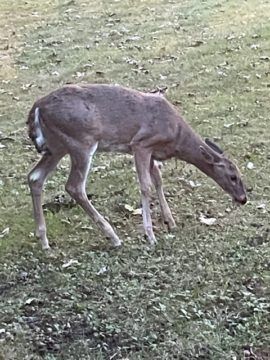by Carol A Westbrook

The intermittent taps on the roof roused me from a deep sleep, and then I remembered the acorns. The acorns had begun dropping. It was the first week of September, the days were still warm, and the leaves were still green. The leaves wouldn’t turn colors and start falling for several weeks yet.
But somehow our oak trees knew it was time to drop their acorns, and all twelve of our oaks began releasing their hard brown nuts with the little caps. The racket came from our larger trees which had branches over the roof; while the chipmunks, squirrels, rabbits, deer and other critters showed up to share the wealth before they bedded down for the winter.
It was acorn season. Acorn season starts at the same time as Pumpkin Pie Spice season does, but it lasts only as long as it takes for the trees to drop all of their nuts, about a week and a half. Pumpkin Pie Spice season, on the other hand, continues through Thanksgiving. Picture it. It’s early September, you are still wearing sandals and shorts, and winter is the last thing on your mind, when all of a sudden you pass a Starbucks and get a whiff of that alluring combination of nutmeg, allspice, ground cinnamon, ginger, and cloves, which, in true Proustian fashion, evokes pleasant memories of fall.
Proust’s observations happen to be scientifically accurate. Researchers have shown that olfactory sensations (aka smells), unlike other sensations, go almost directly to the amygdala and hippocampus, the brain regions related to detailed memory and intense emotion. This conjures up a recollection of where you were the last time you smelled that scent. Other sensations are modified and interpreted before they reach the memory areas.

Madison Avenue was quick to take advantage of this phenomenon, developing the concept of”scent marketing,” to nudge customers into a purchasing frame of mind. The scent of pumpkin pie in the air triggers memories of family, Thanksgiving, holidays; an overall pleasant emotion, the feeling of autumn…and hopefully you’ll remember fall and winter shopping, school supplies, fall wardrobe, shoes and accessories. And don’t forget Thanksgiving. One day it was warm summer, and the next was the same warm day, but my nose told me it was fall.
But back to the acorns.
Our house sits on about an acre of land, which is adjacent to York Woods, a 79-acre forest preserve in Dupage county. On our land is a small grove of 12 red oak trees, all of which are at least 100-150 years old, two of which overhang our roof and pelt it with nuts when the acorns are dropping. Each tree harbors its own community of birds and squirrels. Deer from the woods occasionally visit to browse through our shrubs and gardens; they are mostly does but later in the autumn we may be blessed with a glimpse of a buck or two looking to mate. One doe in particular is a daily visitor at this time of year by herself or with a few other does, and every spring she appears with two fawns, who tag along until mid-August, when they can manage on their own.

The sudden appearance of so many acorns draws a large number of animals out of their trees or burrows to share in the abundance. We’ll see squirrels, chipmunks, a groundhog and deer. They were collecting as many acorns as they could, to eat or to store in caches that they would use sparingly the cold winter weather. The ground hog would soon be hard asleep in hibernation, so he stuffed himself as much as he could while the acorns were dropping. The birds, who for the most part could not rack the shells, pecked on the nutmeats from acorns on our driveway, cracked when our car moved over them.
Deer do not go into full hibernation, but they slow down their activity for the winter, and on particularly cold days they stay in one place, moving very little to conserve their energy and heat. Many of the doe are pregnant with one or two fawns that they will birth in the spring, and must eat enough food to support their gestation. During the summer the deer frequent the oak grove as if they waiting for the acorns to appear. And when the acorns finally appear they feed continuously, gorging themselves until the acorns stop coming.

Acorns are the deer’s favorite food, and when they are available the animals will even bypass a garden or farm full of beans and corn to feed on acorns. When there is a large acorn crop like we had last year (fall of 2021), animals will travel miles and even feed at night in order to consume as much as they can while the windfall continues. It was quite an eerie site to look out my bedroom window in the middle of the night and see a herd of 4 or 5 deer gorging themselves on a banquet of acorns in the light of the moon!
One of the reasons deer favor acorns is because of their nutritional value. Acorns are loaded with protein and carbohydrates, as well as vitamins A, D, and B6 and the minerals iron, calcium and manganese. Most importantly, acorns contain abundant protein. Unlike most plant proteins, acorn protein is complete, containing all the 9 essential amino acids needed in a mammal’s diet: histidine, isoleucine, leucine, lysine, methionine, phenylalanine, threonine, tryptophan, and valine. Another reason the deer favor acorns in their diet is that a grove of red oaks will drop their nuts all at about the same time, so the animals can get most of their winter nutritional needs with a minimum of foraging.
What is surprising to me is that all the trees in this grove drop their acorns at about the same time, several weeks before the leaves drop. This is the time when autumn approaches and the amount of direct sunlight decreases, causing photosynthesis and plant growth to slow down. When this happens, the acorn’s cap, called the cupule, weakens so that it no longer has the strength to hold the acorn strongly to the tree. Although acorn drop is a passive process, it seems that all the trees in a grove drop their acorns at the same time. I checked around my neighborhood and it seemed to be the case that not every oak grove in my area dropped their acorns at the same time as mine did.
This concerted action of oak trees in one locagion made me wonder if there is some way the trees might communicate. When I looked into this, I learned that trees do have ways of communicating. This happens via underground network of fungi which connect individual plants together to form a mycorrhizal fungal network. Trees use the connections to transfer water, nitrogen, carbon and other minerals to neighboring linked trees. These substances provide aid to other trees in need, but also act send messages, such as warning of insect attacks. Some of these networks are exclusive to one species, other are forest-wide networks, jokingly called “the wood-wide web.” Scientists are beginning to understand how this communication works, and possibly learn to send nutrients and possibly even messages. It is possible that my red oak grove has its own network which coordinates the acorn drop. Maybe someday we will ask them!
When you consider the nutritional value of acorns, it, is surprising that we do not eat them–until you taste one. I have, and believe me, they are astringently bitter.  This is due to the high level of tannins they contain. Obviously, they are not unpalatable to deer; perhaps they cannot taste the tannins. Humans can eat acorns if the tannins are removed, which is easily done by leaching with water. The nut can be further prepared by drying and grinding into flour; this is how they were prepared by the many native American tribes who relied on them for food. Acorns were the mainstay of the diet of many Native American tribes, especially in California, where live oaks are abundant. These tribes made acorn flour, which was then cooked into an acorn mush called Wiiwash, a tasty and highly nutritious food.
This is due to the high level of tannins they contain. Obviously, they are not unpalatable to deer; perhaps they cannot taste the tannins. Humans can eat acorns if the tannins are removed, which is easily done by leaching with water. The nut can be further prepared by drying and grinding into flour; this is how they were prepared by the many native American tribes who relied on them for food. Acorns were the mainstay of the diet of many Native American tribes, especially in California, where live oaks are abundant. These tribes made acorn flour, which was then cooked into an acorn mush called Wiiwash, a tasty and highly nutritious food.
With increasing interest in gluten free foods in the US there should be a demand for acorn flour, but so far it has not happened. There are few, if any, commercial acorn growers. Acorn farming does not appear to be a very feasible nut crop, as oak trees do not start producing acorns until they are about 20 years of age. An average 100 year old oak tree will produce about 2500 acorns per year, which is about 15 to 30 pounds of acorns each year. By comparison, an almond tree can start producing as early as 5 years after planting. But the oaks are so tall that harvesting them can be problematic, too.
For me, I’d rather see my tree’s acorns go to feed the small family of deer that hang around in the late summer, eating wild pants and nibbling on my garden, waiting for acorn season. Then we will be visited by these hungry white-tailed deer almost daily, even into the night, while the smaller creatures, the squirrels, chipmunks and rabbits dart into the grove to get an acorn before the does come by. Some times we will see a buck with his tall antlers, following a pack of young does, a few of which will show up with fawns next year.
The acorn is a symbol of growth and unlimited potential; in this small seed is everything that is needed to create the mighty oak. It reminds us of the cycle of life and our own potential, how one acorn can grow into a massive oak and seed an entire forest.
that is needed to create the mighty oak. It reminds us of the cycle of life and our own potential, how one acorn can grow into a massive oak and seed an entire forest.
